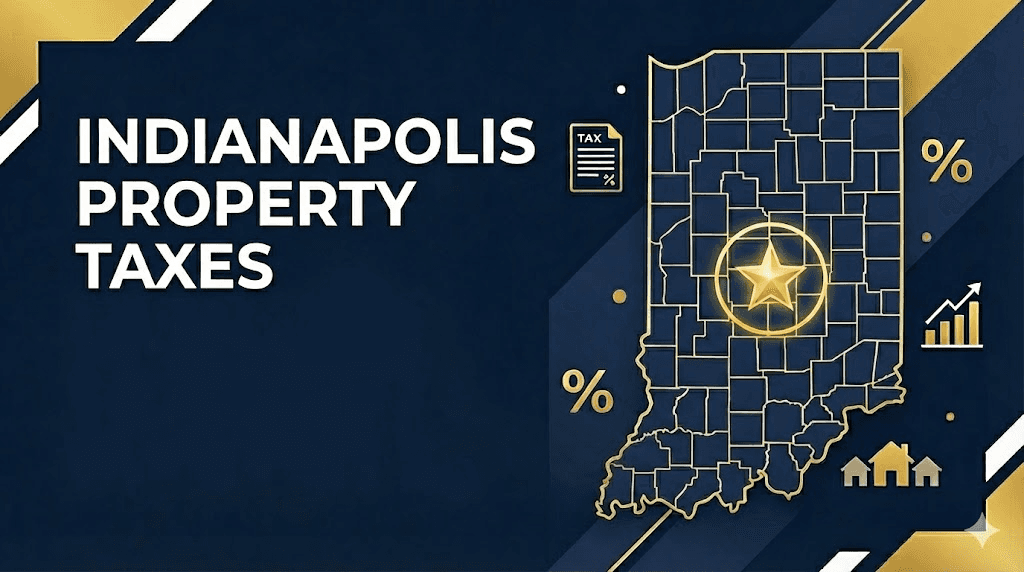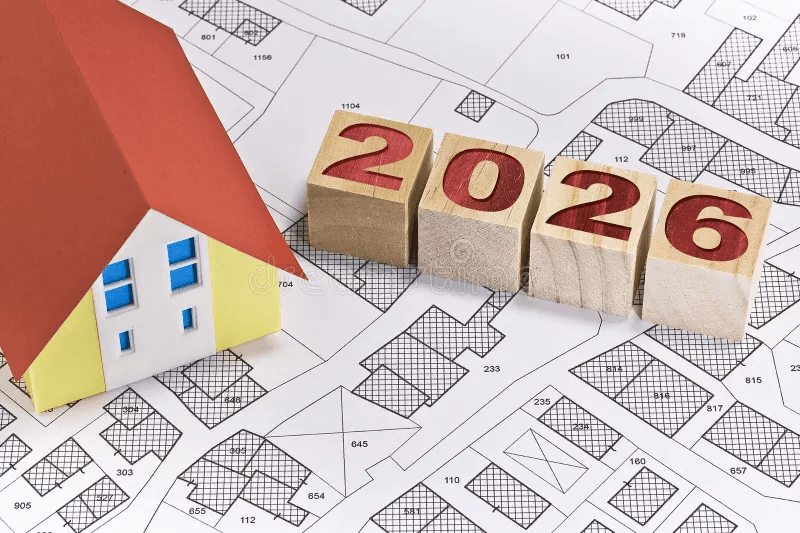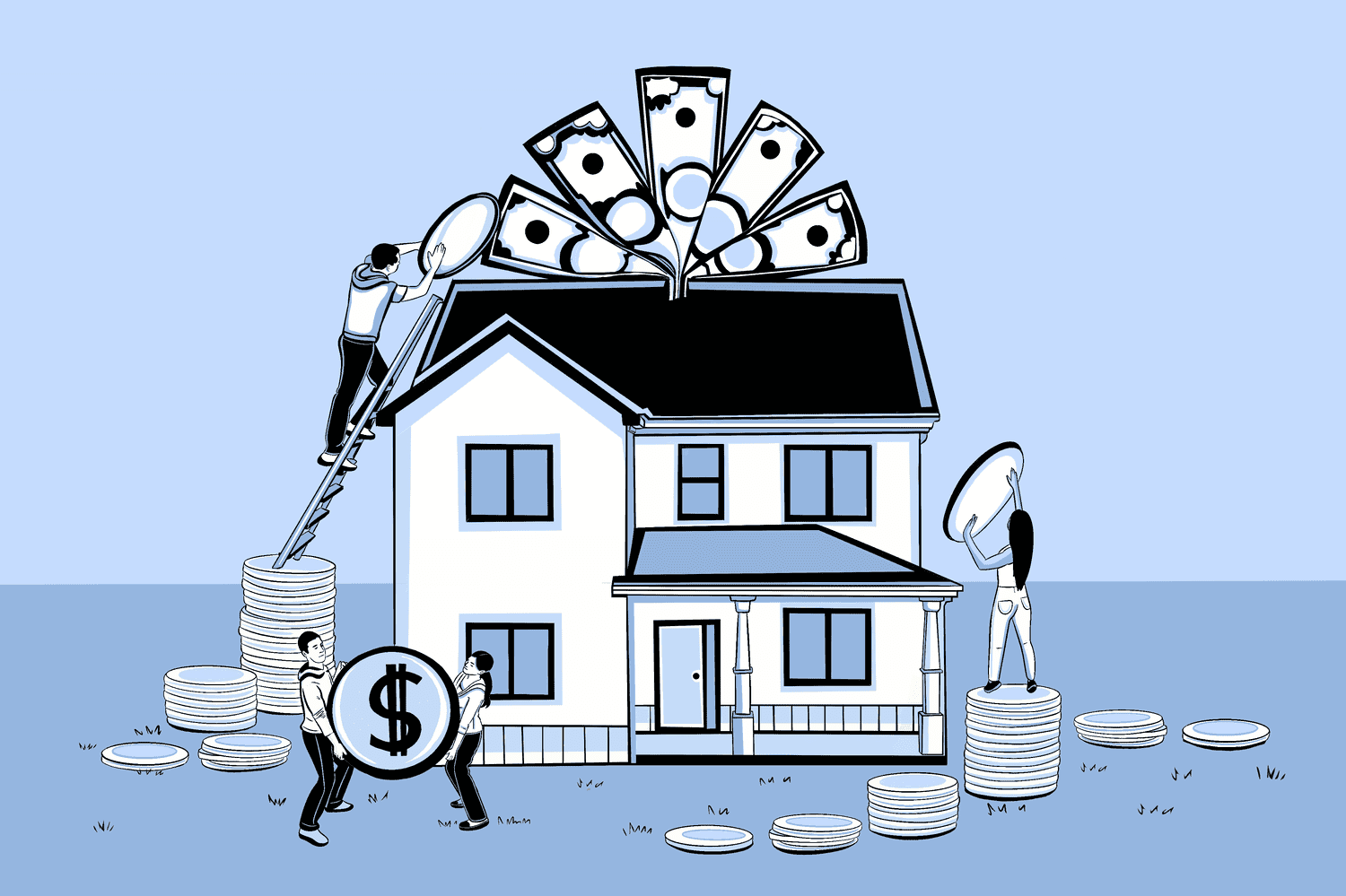Indianapolis has officially graduated from “underrated” to “essential” on the national investor radar. From California to New York, out-of-state buyers are targeting Indy for one key reason: returns that still make sense in 2025.
While coastal and Sun Belt markets are cooling under higher interest rates, Indianapolis offers a sweet spot — affordable buy-ins, strong rent growth, and dependable tenant demand.
If you’re considering buying investment property in the Midwest, here’s why Indianapolis real estate remains one of the best bets for out-of-state investors in 2025.
1. Indy’s Fundamentals Still Outperform
The numbers tell the story. Despite a slowdown in some national metros, Indianapolis real estate continues to outperform.
According to Redfin and Realtor.com (Q3 2025):
Median home price: ~$270,000 (up 2.7% year-over-year)
Median rent: ~$1,395/month (up 3% from 2024)
Vacancy rate: 5.1% (below U.S. average)
Average cap rates: 6–8% — still healthy in a higher-rate environment
Population growth: +1.6% YoY
That balance — steady appreciation and strong rent yields — keeps out-of-state investors buying here while others pull back elsewhere.
For broader context on market ranking and performance, read Indianapolis Ranked a Top 2025 Market: What Investors Should Know.
2. Low Entry Costs + High Cash Flow Potential
Compared to overheated markets like Austin or Phoenix, Indy remains affordable and profitable.
Investors can still find turnkey properties under $250K in stable neighborhoods.
Rent-to-price ratios (0.9–1.1%) are among the strongest in the country.
Maintenance and taxes are lower than national averages.
That affordability allows out-of-state buyers to diversify portfolios — often acquiring multiple Indy rentals for the price of one coastal property.
Even at higher mortgage rates, cash flow margins in Indy remain solid, especially for single-family homes in Speedway, West Indianapolis, or Lawrence Township.
3. Landlord-Friendly Laws + Predictable Costs
Indiana remains one of the most landlord-friendly states in the U.S. — a huge perk for out-of-state investors.
✅ No rent control laws
✅ Straightforward eviction timelines
✅ Property taxes around 0.9–1.1% of assessed value
✅ No local income tax on rental income for nonresidents
Combined, these factors reduce investor headaches and make remote ownership far simpler than in high-regulation markets like California or New York.
4. Consistent Rent Growth and Tenant Demand
Indy’s renter base is wide and diverse — from healthcare and logistics workers to tech employees and families priced out of buying.
Key demand drivers:
Major employers (Eli Lilly, Salesforce, FedEx, IU Health, Cummins)
Rapid population growth in the 25–45 age range
Affordability compared to surrounding metros
Rents have climbed ~3% annually since 2022, according to Realtor.com, with single-family homes and small multifamily units leading the charge.
For a breakdown by neighborhood and property type, check out Indianapolis Rental Market 2025: Trends in Rents and Vacancies.
5. Turnkey + Property Management Infrastructure
Out-of-state investors need boots on the ground — and Indy has them.
The city’s rise as a national investment market has created a robust local ecosystem of:
Turnkey investment companies
Experienced property managers
Investor-friendly Realtors (👋 hi from Roots Realty Co.)
Local lenders offering DSCR and investor loan products
This makes remote ownership practical — even for investors who never step foot in Indiana.
6. Emerging Neighborhoods for 2025
Beyond the established hotspots, up-and-coming areas continue to deliver strong returns.
Neighborhood | Why It’s Hot | Median Price (2025) | Avg Rent |
|---|---|---|---|
Near Eastside | Revitalization, solid tenant base | ~$185K | ~$1,250 |
Garfield Park | Affordable + artsy appeal | ~$225K | ~$1,500 |
Speedway | Cash flow + industrial demand | ~$210K | ~$1,400 |
Bates-Hendricks | Trendy + high resale | ~$310K | ~$1,800 |
West Indianapolis | Entry-level investment zone | ~$190K | ~$1,200 |
Each offers slightly different risk/reward — but together, they represent the full spectrum of Indy’s 2025 opportunity.
7. Long-Term Appreciation Outlook
Indianapolis isn’t a boom-and-bust city. Its growth is steady and sustainable — which is exactly what long-term investors want.
5-Year Outlook (2025–2030):
Projected annual appreciation: 3–4%
Continued rent growth: 2–3% annually
Expanding job base and infrastructure upgrades
With more people relocating from high-cost metros, Indy’s housing supply will remain tight — meaning strong rent growth and gradual appreciation are likely to continue.
8. Financing and Remote Ownership Tips
If you’re buying from out of state, financing and management strategy matter.
Pro tips for remote investors:
Use local lenders who understand Indy rental comps and appraisals.
Work with a property manager before closing to estimate realistic rents.
Consider DSCR loans (no personal income verification) for portfolio growth.
Ask your Realtor for video walk-throughs and inspection reports to minimize surprises.
Roots Realty Co. helps many out-of-state clients do remote closings and tenant placements entirely online — making distance investing smoother than ever.
Investor FAQs: Out-of-State Investing in Indianapolis
Is Indianapolis a good market for remote investing?
Yes — Indy offers low property prices, strong local management options, and stable demand. It’s built for remote portfolio growth.
What kind of returns can I expect?
Typical cash-on-cash returns of 6–10% for rentals, and 3–4% annual appreciation for long-term holds.
Are there risks for out-of-state buyers?
Like any market, you need local insight — but with strong management and a knowledgeable agent, risks are low compared to volatile coastal metros.
What property types work best for remote investors?
Single-family homes and small multifamily properties are easiest to manage remotely and perform best for long-term ROI.
Final Thoughts: Why Out-of-State Investors Love Indy
Indianapolis has officially proven it’s not just a “flyover market.” It’s a cash-flowing, appreciation-stable, investor-friendly city that punches way above its weight.
Whether you’re buying your first rental from afar or scaling up an existing portfolio, Indy offers what most U.S. metros can’t in 2025 — affordable entry prices, reliable tenants, and consistent returns.
Ready to explore Indianapolis investment opportunities? The Roots Realty Co. investor team can help you find, analyze, and manage properties — all from wherever you’re based.
Indianapolis has officially graduated from “underrated” to “essential” on the national investor radar. From California to New York, out-of-state buyers are targeting Indy for one key reason: returns that still make sense in 2025.
While coastal and Sun Belt markets are cooling under higher interest rates, Indianapolis offers a sweet spot — affordable buy-ins, strong rent growth, and dependable tenant demand.
If you’re considering buying investment property in the Midwest, here’s why Indianapolis real estate remains one of the best bets for out-of-state investors in 2025.
1. Indy’s Fundamentals Still Outperform
The numbers tell the story. Despite a slowdown in some national metros, Indianapolis real estate continues to outperform.
According to Redfin and Realtor.com (Q3 2025):
Median home price: ~$270,000 (up 2.7% year-over-year)
Median rent: ~$1,395/month (up 3% from 2024)
Vacancy rate: 5.1% (below U.S. average)
Average cap rates: 6–8% — still healthy in a higher-rate environment
Population growth: +1.6% YoY
That balance — steady appreciation and strong rent yields — keeps out-of-state investors buying here while others pull back elsewhere.
For broader context on market ranking and performance, read Indianapolis Ranked a Top 2025 Market: What Investors Should Know.
2. Low Entry Costs + High Cash Flow Potential
Compared to overheated markets like Austin or Phoenix, Indy remains affordable and profitable.
Investors can still find turnkey properties under $250K in stable neighborhoods.
Rent-to-price ratios (0.9–1.1%) are among the strongest in the country.
Maintenance and taxes are lower than national averages.
That affordability allows out-of-state buyers to diversify portfolios — often acquiring multiple Indy rentals for the price of one coastal property.
Even at higher mortgage rates, cash flow margins in Indy remain solid, especially for single-family homes in Speedway, West Indianapolis, or Lawrence Township.
3. Landlord-Friendly Laws + Predictable Costs
Indiana remains one of the most landlord-friendly states in the U.S. — a huge perk for out-of-state investors.
✅ No rent control laws
✅ Straightforward eviction timelines
✅ Property taxes around 0.9–1.1% of assessed value
✅ No local income tax on rental income for nonresidents
Combined, these factors reduce investor headaches and make remote ownership far simpler than in high-regulation markets like California or New York.
4. Consistent Rent Growth and Tenant Demand
Indy’s renter base is wide and diverse — from healthcare and logistics workers to tech employees and families priced out of buying.
Key demand drivers:
Major employers (Eli Lilly, Salesforce, FedEx, IU Health, Cummins)
Rapid population growth in the 25–45 age range
Affordability compared to surrounding metros
Rents have climbed ~3% annually since 2022, according to Realtor.com, with single-family homes and small multifamily units leading the charge.
For a breakdown by neighborhood and property type, check out Indianapolis Rental Market 2025: Trends in Rents and Vacancies.
5. Turnkey + Property Management Infrastructure
Out-of-state investors need boots on the ground — and Indy has them.
The city’s rise as a national investment market has created a robust local ecosystem of:
Turnkey investment companies
Experienced property managers
Investor-friendly Realtors (👋 hi from Roots Realty Co.)
Local lenders offering DSCR and investor loan products
This makes remote ownership practical — even for investors who never step foot in Indiana.
6. Emerging Neighborhoods for 2025
Beyond the established hotspots, up-and-coming areas continue to deliver strong returns.
Neighborhood | Why It’s Hot | Median Price (2025) | Avg Rent |
|---|---|---|---|
Near Eastside | Revitalization, solid tenant base | ~$185K | ~$1,250 |
Garfield Park | Affordable + artsy appeal | ~$225K | ~$1,500 |
Speedway | Cash flow + industrial demand | ~$210K | ~$1,400 |
Bates-Hendricks | Trendy + high resale | ~$310K | ~$1,800 |
West Indianapolis | Entry-level investment zone | ~$190K | ~$1,200 |
Each offers slightly different risk/reward — but together, they represent the full spectrum of Indy’s 2025 opportunity.
7. Long-Term Appreciation Outlook
Indianapolis isn’t a boom-and-bust city. Its growth is steady and sustainable — which is exactly what long-term investors want.
5-Year Outlook (2025–2030):
Projected annual appreciation: 3–4%
Continued rent growth: 2–3% annually
Expanding job base and infrastructure upgrades
With more people relocating from high-cost metros, Indy’s housing supply will remain tight — meaning strong rent growth and gradual appreciation are likely to continue.
8. Financing and Remote Ownership Tips
If you’re buying from out of state, financing and management strategy matter.
Pro tips for remote investors:
Use local lenders who understand Indy rental comps and appraisals.
Work with a property manager before closing to estimate realistic rents.
Consider DSCR loans (no personal income verification) for portfolio growth.
Ask your Realtor for video walk-throughs and inspection reports to minimize surprises.
Roots Realty Co. helps many out-of-state clients do remote closings and tenant placements entirely online — making distance investing smoother than ever.
Investor FAQs: Out-of-State Investing in Indianapolis
Is Indianapolis a good market for remote investing?
Yes — Indy offers low property prices, strong local management options, and stable demand. It’s built for remote portfolio growth.
What kind of returns can I expect?
Typical cash-on-cash returns of 6–10% for rentals, and 3–4% annual appreciation for long-term holds.
Are there risks for out-of-state buyers?
Like any market, you need local insight — but with strong management and a knowledgeable agent, risks are low compared to volatile coastal metros.
What property types work best for remote investors?
Single-family homes and small multifamily properties are easiest to manage remotely and perform best for long-term ROI.
Final Thoughts: Why Out-of-State Investors Love Indy
Indianapolis has officially proven it’s not just a “flyover market.” It’s a cash-flowing, appreciation-stable, investor-friendly city that punches way above its weight.
Whether you’re buying your first rental from afar or scaling up an existing portfolio, Indy offers what most U.S. metros can’t in 2025 — affordable entry prices, reliable tenants, and consistent returns.
Ready to explore Indianapolis investment opportunities? The Roots Realty Co. investor team can help you find, analyze, and manage properties — all from wherever you’re based.
Indianapolis has officially graduated from “underrated” to “essential” on the national investor radar. From California to New York, out-of-state buyers are targeting Indy for one key reason: returns that still make sense in 2025.
While coastal and Sun Belt markets are cooling under higher interest rates, Indianapolis offers a sweet spot — affordable buy-ins, strong rent growth, and dependable tenant demand.
If you’re considering buying investment property in the Midwest, here’s why Indianapolis real estate remains one of the best bets for out-of-state investors in 2025.
1. Indy’s Fundamentals Still Outperform
The numbers tell the story. Despite a slowdown in some national metros, Indianapolis real estate continues to outperform.
According to Redfin and Realtor.com (Q3 2025):
Median home price: ~$270,000 (up 2.7% year-over-year)
Median rent: ~$1,395/month (up 3% from 2024)
Vacancy rate: 5.1% (below U.S. average)
Average cap rates: 6–8% — still healthy in a higher-rate environment
Population growth: +1.6% YoY
That balance — steady appreciation and strong rent yields — keeps out-of-state investors buying here while others pull back elsewhere.
For broader context on market ranking and performance, read Indianapolis Ranked a Top 2025 Market: What Investors Should Know.
2. Low Entry Costs + High Cash Flow Potential
Compared to overheated markets like Austin or Phoenix, Indy remains affordable and profitable.
Investors can still find turnkey properties under $250K in stable neighborhoods.
Rent-to-price ratios (0.9–1.1%) are among the strongest in the country.
Maintenance and taxes are lower than national averages.
That affordability allows out-of-state buyers to diversify portfolios — often acquiring multiple Indy rentals for the price of one coastal property.
Even at higher mortgage rates, cash flow margins in Indy remain solid, especially for single-family homes in Speedway, West Indianapolis, or Lawrence Township.
3. Landlord-Friendly Laws + Predictable Costs
Indiana remains one of the most landlord-friendly states in the U.S. — a huge perk for out-of-state investors.
✅ No rent control laws
✅ Straightforward eviction timelines
✅ Property taxes around 0.9–1.1% of assessed value
✅ No local income tax on rental income for nonresidents
Combined, these factors reduce investor headaches and make remote ownership far simpler than in high-regulation markets like California or New York.
4. Consistent Rent Growth and Tenant Demand
Indy’s renter base is wide and diverse — from healthcare and logistics workers to tech employees and families priced out of buying.
Key demand drivers:
Major employers (Eli Lilly, Salesforce, FedEx, IU Health, Cummins)
Rapid population growth in the 25–45 age range
Affordability compared to surrounding metros
Rents have climbed ~3% annually since 2022, according to Realtor.com, with single-family homes and small multifamily units leading the charge.
For a breakdown by neighborhood and property type, check out Indianapolis Rental Market 2025: Trends in Rents and Vacancies.
5. Turnkey + Property Management Infrastructure
Out-of-state investors need boots on the ground — and Indy has them.
The city’s rise as a national investment market has created a robust local ecosystem of:
Turnkey investment companies
Experienced property managers
Investor-friendly Realtors (👋 hi from Roots Realty Co.)
Local lenders offering DSCR and investor loan products
This makes remote ownership practical — even for investors who never step foot in Indiana.
6. Emerging Neighborhoods for 2025
Beyond the established hotspots, up-and-coming areas continue to deliver strong returns.
Neighborhood | Why It’s Hot | Median Price (2025) | Avg Rent |
|---|---|---|---|
Near Eastside | Revitalization, solid tenant base | ~$185K | ~$1,250 |
Garfield Park | Affordable + artsy appeal | ~$225K | ~$1,500 |
Speedway | Cash flow + industrial demand | ~$210K | ~$1,400 |
Bates-Hendricks | Trendy + high resale | ~$310K | ~$1,800 |
West Indianapolis | Entry-level investment zone | ~$190K | ~$1,200 |
Each offers slightly different risk/reward — but together, they represent the full spectrum of Indy’s 2025 opportunity.
7. Long-Term Appreciation Outlook
Indianapolis isn’t a boom-and-bust city. Its growth is steady and sustainable — which is exactly what long-term investors want.
5-Year Outlook (2025–2030):
Projected annual appreciation: 3–4%
Continued rent growth: 2–3% annually
Expanding job base and infrastructure upgrades
With more people relocating from high-cost metros, Indy’s housing supply will remain tight — meaning strong rent growth and gradual appreciation are likely to continue.
8. Financing and Remote Ownership Tips
If you’re buying from out of state, financing and management strategy matter.
Pro tips for remote investors:
Use local lenders who understand Indy rental comps and appraisals.
Work with a property manager before closing to estimate realistic rents.
Consider DSCR loans (no personal income verification) for portfolio growth.
Ask your Realtor for video walk-throughs and inspection reports to minimize surprises.
Roots Realty Co. helps many out-of-state clients do remote closings and tenant placements entirely online — making distance investing smoother than ever.
Investor FAQs: Out-of-State Investing in Indianapolis
Is Indianapolis a good market for remote investing?
Yes — Indy offers low property prices, strong local management options, and stable demand. It’s built for remote portfolio growth.
What kind of returns can I expect?
Typical cash-on-cash returns of 6–10% for rentals, and 3–4% annual appreciation for long-term holds.
Are there risks for out-of-state buyers?
Like any market, you need local insight — but with strong management and a knowledgeable agent, risks are low compared to volatile coastal metros.
What property types work best for remote investors?
Single-family homes and small multifamily properties are easiest to manage remotely and perform best for long-term ROI.
Final Thoughts: Why Out-of-State Investors Love Indy
Indianapolis has officially proven it’s not just a “flyover market.” It’s a cash-flowing, appreciation-stable, investor-friendly city that punches way above its weight.
Whether you’re buying your first rental from afar or scaling up an existing portfolio, Indy offers what most U.S. metros can’t in 2025 — affordable entry prices, reliable tenants, and consistent returns.
Ready to explore Indianapolis investment opportunities? The Roots Realty Co. investor team can help you find, analyze, and manage properties — all from wherever you’re based.
Indianapolis has officially graduated from “underrated” to “essential” on the national investor radar. From California to New York, out-of-state buyers are targeting Indy for one key reason: returns that still make sense in 2025.
While coastal and Sun Belt markets are cooling under higher interest rates, Indianapolis offers a sweet spot — affordable buy-ins, strong rent growth, and dependable tenant demand.
If you’re considering buying investment property in the Midwest, here’s why Indianapolis real estate remains one of the best bets for out-of-state investors in 2025.
1. Indy’s Fundamentals Still Outperform
The numbers tell the story. Despite a slowdown in some national metros, Indianapolis real estate continues to outperform.
According to Redfin and Realtor.com (Q3 2025):
Median home price: ~$270,000 (up 2.7% year-over-year)
Median rent: ~$1,395/month (up 3% from 2024)
Vacancy rate: 5.1% (below U.S. average)
Average cap rates: 6–8% — still healthy in a higher-rate environment
Population growth: +1.6% YoY
That balance — steady appreciation and strong rent yields — keeps out-of-state investors buying here while others pull back elsewhere.
For broader context on market ranking and performance, read Indianapolis Ranked a Top 2025 Market: What Investors Should Know.
2. Low Entry Costs + High Cash Flow Potential
Compared to overheated markets like Austin or Phoenix, Indy remains affordable and profitable.
Investors can still find turnkey properties under $250K in stable neighborhoods.
Rent-to-price ratios (0.9–1.1%) are among the strongest in the country.
Maintenance and taxes are lower than national averages.
That affordability allows out-of-state buyers to diversify portfolios — often acquiring multiple Indy rentals for the price of one coastal property.
Even at higher mortgage rates, cash flow margins in Indy remain solid, especially for single-family homes in Speedway, West Indianapolis, or Lawrence Township.
3. Landlord-Friendly Laws + Predictable Costs
Indiana remains one of the most landlord-friendly states in the U.S. — a huge perk for out-of-state investors.
✅ No rent control laws
✅ Straightforward eviction timelines
✅ Property taxes around 0.9–1.1% of assessed value
✅ No local income tax on rental income for nonresidents
Combined, these factors reduce investor headaches and make remote ownership far simpler than in high-regulation markets like California or New York.
4. Consistent Rent Growth and Tenant Demand
Indy’s renter base is wide and diverse — from healthcare and logistics workers to tech employees and families priced out of buying.
Key demand drivers:
Major employers (Eli Lilly, Salesforce, FedEx, IU Health, Cummins)
Rapid population growth in the 25–45 age range
Affordability compared to surrounding metros
Rents have climbed ~3% annually since 2022, according to Realtor.com, with single-family homes and small multifamily units leading the charge.
For a breakdown by neighborhood and property type, check out Indianapolis Rental Market 2025: Trends in Rents and Vacancies.
5. Turnkey + Property Management Infrastructure
Out-of-state investors need boots on the ground — and Indy has them.
The city’s rise as a national investment market has created a robust local ecosystem of:
Turnkey investment companies
Experienced property managers
Investor-friendly Realtors (👋 hi from Roots Realty Co.)
Local lenders offering DSCR and investor loan products
This makes remote ownership practical — even for investors who never step foot in Indiana.
6. Emerging Neighborhoods for 2025
Beyond the established hotspots, up-and-coming areas continue to deliver strong returns.
Neighborhood | Why It’s Hot | Median Price (2025) | Avg Rent |
|---|---|---|---|
Near Eastside | Revitalization, solid tenant base | ~$185K | ~$1,250 |
Garfield Park | Affordable + artsy appeal | ~$225K | ~$1,500 |
Speedway | Cash flow + industrial demand | ~$210K | ~$1,400 |
Bates-Hendricks | Trendy + high resale | ~$310K | ~$1,800 |
West Indianapolis | Entry-level investment zone | ~$190K | ~$1,200 |
Each offers slightly different risk/reward — but together, they represent the full spectrum of Indy’s 2025 opportunity.
7. Long-Term Appreciation Outlook
Indianapolis isn’t a boom-and-bust city. Its growth is steady and sustainable — which is exactly what long-term investors want.
5-Year Outlook (2025–2030):
Projected annual appreciation: 3–4%
Continued rent growth: 2–3% annually
Expanding job base and infrastructure upgrades
With more people relocating from high-cost metros, Indy’s housing supply will remain tight — meaning strong rent growth and gradual appreciation are likely to continue.
8. Financing and Remote Ownership Tips
If you’re buying from out of state, financing and management strategy matter.
Pro tips for remote investors:
Use local lenders who understand Indy rental comps and appraisals.
Work with a property manager before closing to estimate realistic rents.
Consider DSCR loans (no personal income verification) for portfolio growth.
Ask your Realtor for video walk-throughs and inspection reports to minimize surprises.
Roots Realty Co. helps many out-of-state clients do remote closings and tenant placements entirely online — making distance investing smoother than ever.
Investor FAQs: Out-of-State Investing in Indianapolis
Is Indianapolis a good market for remote investing?
Yes — Indy offers low property prices, strong local management options, and stable demand. It’s built for remote portfolio growth.
What kind of returns can I expect?
Typical cash-on-cash returns of 6–10% for rentals, and 3–4% annual appreciation for long-term holds.
Are there risks for out-of-state buyers?
Like any market, you need local insight — but with strong management and a knowledgeable agent, risks are low compared to volatile coastal metros.
What property types work best for remote investors?
Single-family homes and small multifamily properties are easiest to manage remotely and perform best for long-term ROI.
Final Thoughts: Why Out-of-State Investors Love Indy
Indianapolis has officially proven it’s not just a “flyover market.” It’s a cash-flowing, appreciation-stable, investor-friendly city that punches way above its weight.
Whether you’re buying your first rental from afar or scaling up an existing portfolio, Indy offers what most U.S. metros can’t in 2025 — affordable entry prices, reliable tenants, and consistent returns.
Ready to explore Indianapolis investment opportunities? The Roots Realty Co. investor team can help you find, analyze, and manage properties — all from wherever you’re based.








